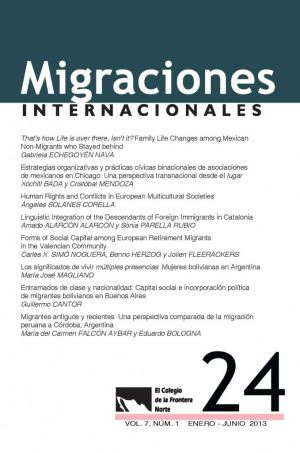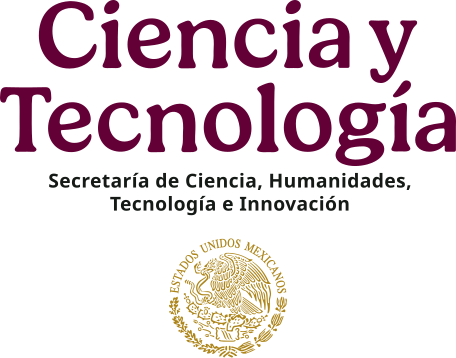Forms of Social Capital among European Retirement Migrants in the Valencian Community
DOI:
https://doi.org/10.17428/rmi.v6i24.712Palabras clave:
retirement migration, social capital, transnationalism, Valencian community, Costa BlancaResumen
This article analyzes social capital among European pensioners retired in Valencia. The objects of the study are associations and clubs for European retired migrants. We analyzed the self-advertisement of these associations and conducted 18 structured interviews with key informants. In addition, we also conducted a case study of an association whose objective is the improvement of the access to health services.
We found a predominance of bonding capital: strong intra-group identity
and lack of contact with the host society. We suggest that this transnational social space of retirees causes a fourth form of social capital, linking bonding capital, through the setting of vertical links to strengthen the group, based on the perceptionof a similar identity and trust in power and resource endowments.
Tipos de capital social entre los inmigrantes europeos retirados
en la Comunidad Valenciana
Resumen
Este artículo analiza el capital social entre los pensionistas europeos retirados en la Comunidad Valenciana. El objeto de estudio lo constituyen las asociaciones y clubes. Se analizan los espacios publicitarios en los que se dan a conocer y se realizan 18 entrevistas semiestructuradas a informantes clave. Así mismo se lleva a cabo un estudio de caso sobre una asociación cuyo objetivo es mejorar el acceso a los servicios sanitarios.
Se evidencia un predominio del capital de refortalecimiento del grupo: fuerte identidad intragrupo y falta de contacto con la sociedad de acogida.Se sugiere que este espacio social transnacional de jubilados provoca una cuarta forma de capital social –el establecimiento de vínculos verticales para reforzar el grupo– basada en la percepción de una identidad similar y la confianza en fuentes de poder y recursos.
Referencias
ACKERS, Louise, and Peter DWYER, 2004, “Fixed Laws, Fluid
Lives: The Citizenship Status of Post-Retirement Migrants in the
European Union”, Ageing and Society, vol. 24, no. 3, pp. 451-475.
ALAMINOS, Antonio, and Oscar SANTACREU, 2009, “Living
across Cultures in a Transnational Europe”, in Ettore Recchi
and Adrian Favell, eds., Pioneers of European Integration.
Citizenship and Mobility in the EU, Cheltenham, United Kingdom,
Edward Elgar Publishing, 98-119.
ARNEIL, Barbara, 2007, “Global Citizenship and Empire”, Citizenship
Studies, vol. 11, no. 3, pp. 301-328.
BECK-GERNSHEIM, Elisabeth, 2004, Wir und die Anderen.
Vom Blick der Deutschen auf Migranten und Minderheiten,
Frankfurt, Suhrkamp Verlag.
BENSON, Michaela and Karen O’REILLY, 2009, “Migration
and the Search for a Better Way of Life: A Critical Exploration
of Lifestyle Migration”, The Sociological Review, vol. 57, no. 4,
pp. 608-625.
BOURDIEU, Pierre, 1986, “The Forms of Capital”, in John Richardson,
ed., Handbook of Theory and Research for the Sociology
of Education, New York, Greenwood Press, pp. 241-258.
BRAUN, Michael, and Camelia ARSENE, 2009, “The Demographics
of Movers and Stayers in the European Union”, in
Ettore Recchi and Adrian Favell, eds., Pioneers of European In-
tegration. Citizenship and Mobility in the EU, Cheltenham, United
Kingdom, Edward Elgar Publishing, pp. 26-51.
CASADO-DÍAZ, María Ángeles, 2009, “Social Capital in the
Sun. Bonding and Bridging Social Capital among British Retirees”,
in Michaela Benson and Karen O’Reilly, eds., Lifestyle
Migration. Expectations, Aspirations and Experiences, Burlington,
United States, Ashgate Publishing Company, pp. 87-102.
CASADO-DÍAZ, María Ángeles; Claudia KAISER, and Anthony
WARNES, 2004, “Northern European Retired Residents
in Nine Southern European Areas: Characteristics,
Motivations and Adjustment”, Ageing and Society, no. 24, pp.
-381.
CHEONG, Pauline et al., 2007, “Immigration, Social Cohesion
and Social Capital: A Critical Review”, Critical Social Policy,
vol. 27, no. 1, pp. 24-49.
DURKHEIM, Emile, 1947, The Division of Labor in Society
(translated by George Simpson), New York, The Free Press.
DWYER, Peter, 2001, “Retired eu Migrants, Healthcare Rights
and European Social Citizenship”, The Journal of Social Welfare
and Family Law, vol. 23, no. 3, pp. 311-327.
DWYER, Peter, and Dimitris PAPADIMITRIOU, 2006, “The
Social Security Rights of Older International Migrants in the
European Union”, Journal of Ethnic and Migration Studies, vol.
, no. 8, pp. 1301-1319.
FAVELL, Adrien, 2003, Eurostars and Eurocities: Towards a Sociology
of Free Moving Professionals in Western Europe, San Diego,
United States, Center for Comparative Immigration Studies.
FERRAGINA, Emanuele, 2009, “Social Capital and Equality:
Toc queville’s Legacy”, Luxembourg, Luxembourg, Income
Study Database (Working Paper, no. 515).
GITTEL, Ross, and Avis VIDAL, 1998, Community Organizing:
Building Social Capital as a Development Strategy, Newbury
Park, United States, Sage.
GRANOVETTER, Mark, 1973, “The Strength of Weak Ties”,
American Journal of Sociology, vol. 78, no. 6, pp. 1360-1380.
GUSTAFSON, Per, 2008, “Transnationalism in Retirement Migration:
The Case of North European Retirees in Spain”, Ethnic
and Racial Studies, vol. 31, no. 3, pp. 451-475.
HUBER, Andreas, 2003, Sogdes Südens. Altersmigration von der
Schweiz nach Spanien am Beispiel Costa Blanca, Zurich, Seismo
Verlag.
HUBER, Andreas, and Karen O’REILLY, 2004, “The Construction
of Heimat under Conditions of Individualised Modernity:
Swiss and British Elderly Migrants in Spain”, Ageing and Society,
vol. 24, no. 3, May, pp. 327-351.
HURTADO, Inmaculada, 2010, “Now, it’s my Turn. Dimensiones
de los cuidados en la inmigración de jubilados noreuropeos
a la Costa Blanca”, in Mari Luz Esteban, Josep María Comelles,
and Carmen Díez Mintegui, eds., Antropología, género, salud
y atención, Barcelona, Bellaterra, pp. 275-298.
INSTITUTO NACIONAL DE ESTADISTICA (INE), 2010,
“Explotación estadística del Padrón. Revisión del Padrón Municipal
Datos a nivel nacional, comunidad autónoma y
provincia”, Madrid, ine. Available at <http://www.ine.es/ineb
menu/mnu_cifraspob.htm> (last accessed on February 7, 2012).
INSTITUTO NACIONAL DE ESTADISTICA, 2011,“Explotación
estadística del Padrón. Revisión del Padrón Municipal
Datos a nivel nacional, comunidad autónomay provincia”,
Madrid, ine. Available at <http://www.ine.es/inebmenu/
mnu_cifraspob.htm> (last accessed on February 7, 2012).
KING, Russell, 2002, “Towards a New Map of European migration”,
International Journal of Population Geography, vol. 8, pp.
-106.
KING, Russell; Anthony Michael WARNES, and Allan WILLIAMS,
, “International Retirement Migration in Europe”,
International Journal of Population Geography, vol. 4, pp. 91-111.
KYLE, David, 2000, Transnational Peasants: Migrations, Networks,
and Ethnicity in Andean Ecuador, Baltimore, John Hopkins
University Press.
MARTINÓN RIBOT, Guillermo, 2009, “Las prestaciones de
asistencia sanitaria en los reglamentos comunitarios sobre se
guridad social. Problemática que genera su aplicación en la Comunidad
Autónoma de Canarias”, Revista de Administración
Sanitaria, vol. 7, no. 4, pp. 639-660.
ODMALM, Pontus, 2004, “Civil Society, Migrant Organisations
and Political Parties: Theoretical Linkages and Applications
to the Swedish Context”, Journals of Ethnic and Migration
Studies, vol. 30, no. 3, pp. 471-489.
OLIVER, Caroline, and O’REILLY, Karen, 2010, “A Bourdieusian
Analysis of Class and Migration: Habitus and the Individualising
Process”, Sociology, vol. 44, no. 1, pp. 49-66.
O’REILLY, Karen, 2000, The British on the Costa del Sol, London,
Routledge.
O’REILLY, Karen, 2007, “Intra-European Migration and the Mobility-
Enclosure Dialectic”, Sociology, vol. 41, no. 2, pp. 277-293.
PORTES, Alejandro, 1995, “Economic Sociology and the Sociology
of Immigration: A Conceptual Overview”, in Alejandro
Portes, ed., The Economic Sociology of Immigration, New York,
Russell Sage Foundation, pp. 1-41.
PORTES, Alejandro, 1998, “Social Capital: Its Origins and Applications
in Modern Sociology”, Annual Review of Sociology,
no. 24, pp. 1-24.
PORTES, Alejandro, 2001, “Introduction: The Debates and Significance
of Immigrant Transnationalism”, Global Issues, vol. 1,
no. 3, pp. 181-193.
PORTES, Alejandro, and Robert BACH, 1985, Latin Journey:
Cuban and Mexican Immigrants in the United States, Berkeley,
University of California Press.
PRIES, Ludger, 2007, Die Transnationalisierung der Sozialen Welt:
Sozialräume Jenseits von Nationalgesellschaften, Berlin, Suhrkamp
Verlag (Edition Suhrkamp, 2521).
PUTNAM, Robert, 1995, “Bowling Alone: America's Declining
Social Capital”, Journal of Democracy, vol. 6, no. 1, pp. 65-78.
PUTNAM, Robert, 2000, Bowling Alone: The Collapse and Revival
of American Community, New York, Simon and Schuster.
PUTNAM, Robert, 2007, “E Pluribus Unum: Diversity and
Community in the Twenty-first Century The 2006 Johan
Skytte Prize Lecture”, Scandinavian Political Studies, vol. 30,
no. 2, June, pp. 137-174.
RODRÍGUEZ, Vicente; María Ángeles CASADO-DÍAZ, and
Andreas HUBER, 2005, “Una perspectiva actual de la migración
internacional de jubilados a España”, in Vicente Rodríguez,
María Ángeles Casado-Díaz, and Andreas Huber, eds.,
La migración de europeos retirados en España, Madrid, Consejo
Superior de Investigaciones Científicas.
RODRÍGUEZ, Vicente; Raúl LARDIÉS, and Paz RODRÍ-
GUEZ, 2010, “Migration and the Registration of European
Pensioners in Spain”, ARI, Madrid, Real Instituto Elcano, vol.
, 17 pp.
SIMÓ NOGUERA, Carles, and Benno HERZOG, 2005, “El
asociacionismo de los residentes europeos en la Comunidad
Valenciana”, in Tomás Mazón, and Antonio Aledo, eds., Turismo
residencial y cambio social, Alicante, Spain, Agua Clara,
pp. 427-454.
SIMÓ NOGUERA, Carles, and Francisco TORRES PÉREZ,
, “Tipos de inmigrantes, inserción social y asociacionismo.
El caso de la Comunidad Valenciana”, in Francisco Checa Olmos,
Ángeles Arjona Garrido, and Juan Carlos Checa Olmos,
eds., Transitar por espacios comunes. Inmigración, salud y ocio,
Barcelona, Icaria, pp. 285-314.
SZRETER, Simon, 2002, “The State of Social Capital. Bringing
Back in Power, Politics and History”, Theory and Society, vol.
, no. 5, October, pp. 573-621.
SZRETER, Simon, and WOOLCOCK, Michael, 2004, “Health
by Association? Social Capital, Social Theory and the Political
Economy of Public Health”, International Journal of Epidemiology,
vol. 33, no. 4, pp. 650-667.
TRIANDAFYLLIDOU, Anna, 2008, “Sub-Saharan African Im -
migrant Activists in Europe: Transcultural Capital and Transcultural
Community Building”, Ethnic and Racial Studies, vol.
, no. 1, pp. 93-116.
VERTOVEC, Steven, 2009, Transnationalism, Abingdon, United
Kingdom, Routledge.
WARNES, Anthony et al., 1999, “The Well-Being of British
Expatriate Retirees in Southern Europe”, Ageing and Society,
Cambridge, United Kingdom, Cambridge University Press, no.
, pp. 717-740.
WEBER, Max, 1904, “Die ‘Objektivität’ Sozialwissenschaftlicher
Erkenntnis”, In J. Winkelmann, ed., Max Weber: Soziologie,
Weltgeschichtliche Analysen, Politik, Stuttgart, Kröner Verlag,
vol. 229, pp.186-262.
WOOLCOCK, Michael, 1998, “Social Capital and Economic
Development: Toward a Theoretical Synthesis and Policy
Frame work”, Theory and Society, vol. 27, no. 2, pp. 151-208.
ZETTER, Roger et al., 2006, Immigration, Social Cohesion and
Social Capital. What are the Links?, Layerthorpe, England, Joseph
Rowntree Foundation/Oxford Brookes University.
Descargas
Publicado
Número
Sección
Licencia
Las/los autoras/es que publiquen en esta revista aceptan las siguientes condiciones:
- Las/los autoras/es conservan los derechos de autor y ceden a la revista Migraciones Internacionales (RMI) el derecho de la primera publicación, mediante el registro de los textos con la licencia de Creative Commons Atribución-No comercial-Sin derivar 4.0 internacional (CC BY-NC-ND 4.0), que permite a terceros utilizar lo publicado siempre que mencionen la autoría del trabajo y a la primera publicación en esta revista.
- Autorizan que su artículo y todos los materiales incluidos en él sean reproducidos, publicados, traducidos, comunicados y transmitidos públicamente en cualquier forma o medio; así como efectuar su distribución al público en el número de ejemplares que se requieran y su comunicación pública, en cada una de sus modalidades, incluida su puesta a disposición del público a través de medios electrónicos o de cualquier otra tecnología, para fines exclusivamente científicos, culturales, de difusión y sin fines comerciales.
- Los autores/as pueden realizar otros acuerdos contractuales independientes y adicionales para la distribución no exclusiva de la versión del artículo publicado en esta revista (por ejemplo: incluirlo en un repositorio institucional, página web personal; o bien publicarlo en un libro) siempre que sea sin fines comerciales e indiquen claramente que el trabajo se publicó por primera vez en Migraciones Internacionales (RMI), [agregando la ficha bibliográfica correspondiente: Autor/es. (año). Título del artículo. Migraciones Internacionales, volumen (número), pp. doi: xxxx ].
Para ello, las/los autoras/es deben remitir el formato de carta-cesión de la propiedad de los derechos de la primera publicación debidamente llenado y firmado. Este documento debe cargarse en formato PDF en archivos complementarios dentro de la plataforma OJS.
Este obra está bajo una licencia de Creative Commons Atribución-No comercial-Sin derivar 4.0 internacional (CC BY-NC-ND 4.0)..













